Article and Photos by Rich Thom
Clinic Chair Rich Blake welcomed 27 members and one new attendee, John Ballay of Coupeville (who we hope will become one of our regulars) to the January program: “Weathering Techniques for Buildings”. Rich reviewed the calendar of upcoming events in the PNR and reminded everyone that, as the new year has arrived, it was a good time to renew NMRA memberships. There being no old or new business, things moved directly into the program.
All had been encouraged to bring a weathered (or possibly not) building to share. Modelers responded by bringing more than two dozen structures in all scales from “N” to “F”, so there were plenty of examples to discuss. Space limitations prevent showing all of them in this report.
Several members described their buildings and construction and weathering methods: Rich Blake, Jack Tingstad, Dick Haines, Terry Kandzor, Susan Gonzales, Al Frasch, Tom Hawkins, John Marshall, and John White. Some common techniques include:
- Use real life: photographs, field trip sketches and notes, internet resources
- Weather wood with razor saw or Micromark “stresser” to create grain
- Stain wood with water or alcohol-based washes made from acrylics, india ink, or leather dyes, or use commercially available stains from Micromark, Builders-in-Scale and others
- Focus on irregularity and repairs: for wood structures built board-by-board, stain boards individually, varying the intensity; put a few new, unpainted boards in an old planked wall; add boarded-up doors and windows, broken trim etc.
- Use chalks for final weathering: Bragdon powders (which contain a binder and need not be fixed in place), Doc O’Brien’s, artists’ chalks from Michael’s
- Instead of chalks apply dry pigments, available from art supply sources e.g. Dick Blick
- Don’t forget roofs: missing shingles, rusted corrugated iron, moss, leaves, foliage
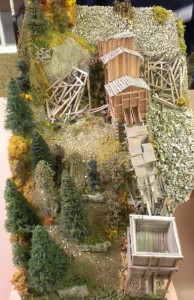
Fig 2 – Jack Tingstad’s abandoned mine, a scratch foreground model built board-by-board; note individually stained boards.
During his remarks, Jack Tingstad passed around copies of the Judges’ Score Sheet for NMRA Model Contests to make the point that weathering can make or break a model earning an achievement award or winning a contest. Of the five qualities of a model that are judged, the fourth, “Finish and Lettering”, which includes weathering and how it was achieved, can earn a maximum of 25 points (out of 125 total possible), which is more than Detail (20 points) or Scratchbuilding (15 points).
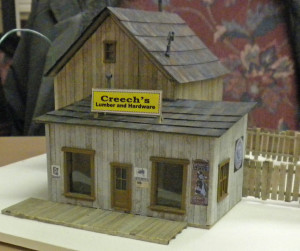
Fig 3 – Tom Hawkins’ Builder’s Supply, another scratch foreground building constructed of pre-stained stripwood.
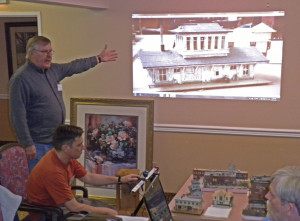
Fig 4 – Terry Kandzor describes his scratch-built yard office/interlocking tower, featuring a boarded-up door for former stairway, broken trim under eaves, and other “needs repair” details.
Some less common methods:
- Weathering boards: stain or paint as usual, apply turpentine, paint the board before it dries with acrylics, then apply tape and pull it off; when it works (it didn’t tonight!) the resulting worn paint appearance is great (Rich Blake)
- Peeling paint: apply Grumbacher “Miskit” Liquid Frisket over first layer of paint in patches where you want the peeled paint effect; apply second coat of paint; then use an artist’s gum eraser to rub off the top layer and masking material (Jack Tingstad)
- “Chalk Slag”: when weathering a building with chalks, place a large clean sheet of paper underneath the model to collect the residue; the co-mingling of colors creates a great weathering powder for general use (Dick Haines)
- Water staining (literally!): drip small amounts of water, possibly with pigments added, vertically down sides of buildings, on roofs etc. (take care with paper-based or wood structures!) (Dick Haines)
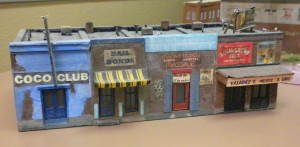
Fig 6 – Susan Gonzales’ city block, the same kit as Dick Haines’; her rendering includes peeled paint exposing bricks underneath and other fine weathering techniques.
Finally, for those who like to let natural processes do the work for them, Tom Hawkins reminded everyone that just leaving a building on the layout for a few years is very effective. (We assume he wasn’t kidding.) Or as John Marshall suggested, build a garden railway. John brought two 1:20.3 buildings from his Coupeville railroad. One, a German plastic model, has been outside for 20 years and looked it. The second, of wood, is brought indoors over the winter but, protected by wood preservative, is outdoors the rest of the year, and was convincingly weathered, too. Whatever works!
Thanks to all participants, and Event Coordinators Rich Blake and Susan Gonzales, for a great clinic on improving the appearance and realism of our structures.

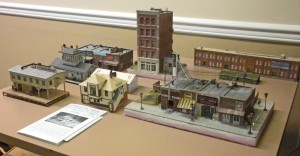

No Comments Yet